Since the appearance of the first cars, designers have been faced with the question of search the best way damping body vibrations arising when overcoming irregularities. The best solution, which is still used today, is the integration into the composition car suspension special devices - shock absorbers. On the this moment hydraulic telescopic shock absorbers are ubiquitous. Damping of vibrations of the body and wheels occurs in them due to fluid friction that occurs when fluid passes through narrow holes in the piston - valves. Thus, the mechanical energy of vibrations is converted into thermal energy. The characteristics of shock absorbers depend on such important indicators as stability, controllability and smoothness of the vehicle. Modern shock absorbers, based on general principle works differ in types and design features.
Friction shock absorbers
The first cars with leaf spring suspension had an unpleasant property: when overcoming irregularities, their body swayed strongly. Initially, this problem was partially solved by itself, since the effect of inter-sheet friction was observed in the multi-leaf springs, which contributed to the damping of body vibrations. But that was not enough.
Therefore, the next step was to add a separate damping element to the suspension. One of the first such devices were dry friction shock absorbers with friction discs developed at the beginning of the last century.
In the 1950s, telescopic piston oil shock absorbers began to be used, which were based on the principle of fluid friction. Their device, borrowed from the design of aircraft chassis, is used in the suspension of cars today.
Shock absorber functions
Front and rear shock absorbers are damping elements of the vehicle's suspension. Paired with elastic elements suspension (springs or torsion bars), shock absorbers perform the following main functions:
- damping vibrations of the car body and wheels
- maintaining contact of the wheel with the supporting surface
- ensuring the smooth running of the car
Automotive shock absorber design
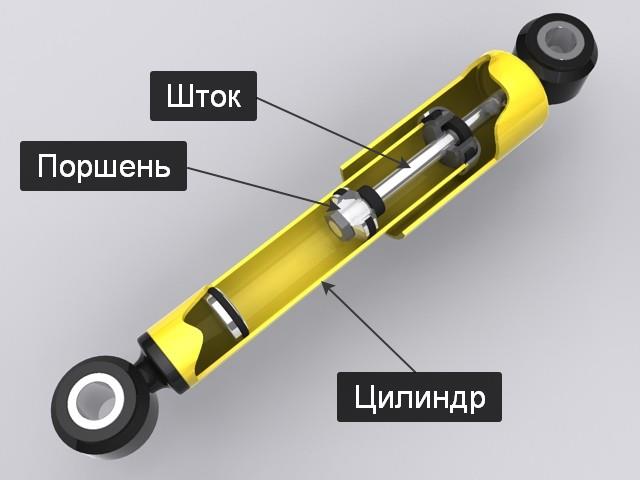 Hydraulic shock absorber design
Hydraulic shock absorber design Shock absorbers are of two types: one-pipe or two-pipe. The design of the shock absorber also depends on the type. Despite this, the basic elements of both types remain in common. The shock absorber consists of a cylinder filled with special liquid(oil) along which the piston moves. The piston itself is connected to a circular rod, which, in turn, is attached to the car body with its upper part. Small diameter holes (valves) are made in the piston through which the liquid passes. In order to increase the resistance to fluid flow, they are made spring-loaded. A more detailed description of the shock absorber design is given below.
The shock absorber is connected to the suspension arm or axle beam. The shock absorber is mounted through an elastic connection - silent block.
The principle of the shock absorber
Oil shock absorbers work on the principle of converting the energy of fluid friction into heat. The moving piston rod forces the oil to flow through the small valves, thereby creating resistance to its movement. Maximum stroke The piston rod defines the shock absorber bump stop. The front shock absorbers take a fairly large load, so they are made more reinforced than the rear.
Shock Absorber Classification
Double tube shock absorber
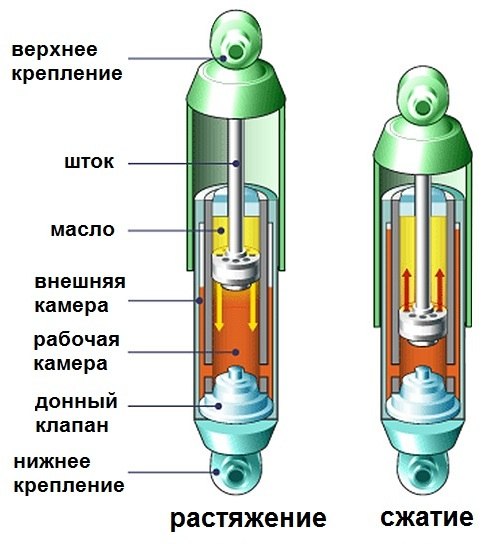 Diagram of a two-tube shock absorber
Diagram of a two-tube shock absorber A double-tube shock absorber consists of coaxial cylinders, one of which is placed inside the other. The piston rod moves in the inner cavity - the working chamber. It communicates with the external, partially filled with air or nitrogen through the bottom valve. A chamber filled with gas is designed to compensate for the volume of liquid when the stem is immersed.
Advantages:
- simple construction and not high price making
- short length
- low internal pressure (performance is maintained if a small amount of oil leaks through the stuffing box)
- soft damping of suspension shocks
- better resistance to mechanical damage
Flaws:
- foaming oil after long-term work and, as a consequence, a decrease in the damping efficiency
- insufficient cooling
- installation, storage and transportation of the shock absorber is carried out only in one position - with the rod up
Both front and rear shock absorbers can have a twin-tube design. But still, in most cases on modern cars, twin-tube shock absorbers are installed on rear axle.
Single tube shock absorber
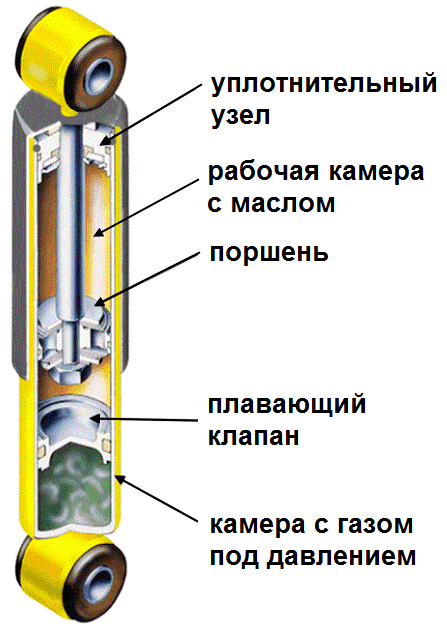 Single-tube shock absorber diagram
Single-tube shock absorber diagram Single-tube shock absorbers are gas-filled. Their design provides only one cylinder, in the lower part of which there is a chamber filled with gas under a pressure of 2 ... 3 MPa. This chamber is separated from the liquid by a special floating piston and is designed to compensate for the volume of liquid when the shock absorber is compressed. Due to the fact that the gas constantly presses the liquid in the working chamber, during the high-frequency mode of operation of the shock absorber, the effect of foaming of the oil (emulsification) is prevented, and it also becomes possible to install it in any position.
Advantages:
- better damping and stability
- improved cooling compared to a two-pipe system
- the ability to install the shock absorber in any position
Flaws
- long shock absorber length
- low resistance to mechanical stress
- high manufacturing costs due to the use of better seals and materials for the body
Single-tube gas-filled shock absorbers are capable of withstanding severe loads without loss of performance. They are mainly used as front shock absorbers.
Variable valve adjustable shock absorbers
Adaptive (or adjustable) dampers assume the ability to change the damping properties (damping coefficient). Shock absorbers are equipped with solenoid valve, the cross section of which changes under the influence of an electrical signal. Reducing the cross section makes it difficult for fluid to pass through the valve, increasing the stiffness of the shock absorber. An increase in the valve section, on the contrary, makes it softer.
Adaptive dampers with magnetorheological fluid
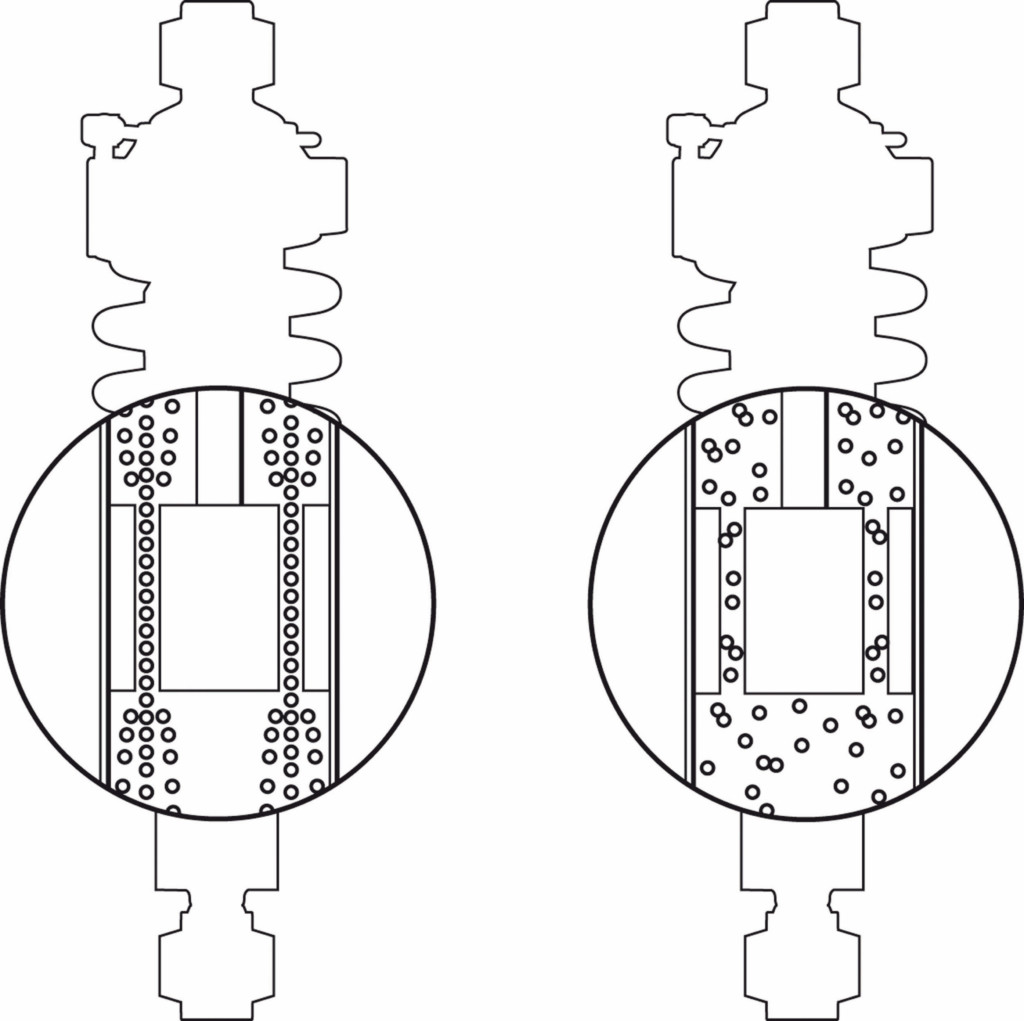 Scheme of action of a magnetorheological fluid
Scheme of action of a magnetorheological fluid This type of adjustable shock absorber is filled with liquid containing metal particles. This oil changes its structure under the influence of a magnetic field, which is created using coils built into the shock absorber piston. Thanks to the magnetorheological fluid, the magnetic shock absorbers change the stiffness characteristics in a fraction of a second. The advantage of adaptive dampers is the ability to change the characteristics of the suspension in accordance with the current driving conditions: a stiffer suspension will improve the handling and stability of the car, while a softer one will increase ride comfort. The main disadvantage adaptive shock absorber: the high cost of its manufacture.
Sports shock absorbers
Sports shock absorbers are designed to withstand extreme loads. They are distinguished by increased rigidity and stability, which provide better vehicle handling.
Major malfunctions and service life of shock absorbers
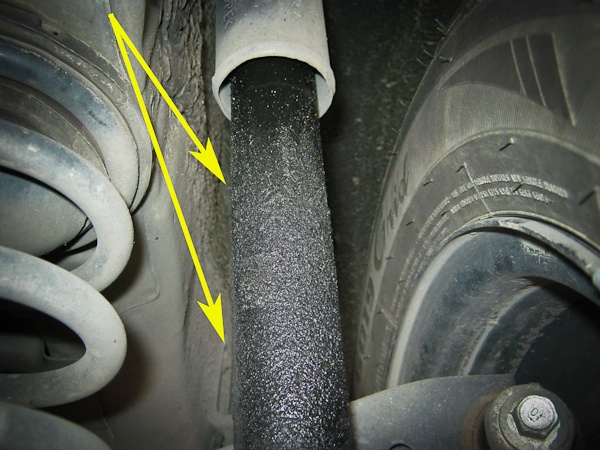 Oil leakage through the shock absorber seal
Oil leakage through the shock absorber seal The most frequent failure of a shock absorber is a violation of the tightness of the stem sealing gland. This happens if the shock absorber boot is damaged, and, as a result, dirt gets on the surface of the stem. Damage to the stem packing will result in gas leakage and shock absorber fluid, due to which the shock absorber itself loses its damping properties.
Under normal operating conditions, the service life of shock absorbers can be 3-5 years or more. The front shock absorbers undergo a heavy load, however, on a new car, their resource is approximately 100-125 thousand kilometers. Rear shock absorbers usually exceed these values.
Whatever the road and modern car convenience and comfort of movement primarily depend on the operation of the suspension on it. This is especially acute on domestic roads... It is no secret that the most important part of the suspension for comfort is the shock absorber. Therefore, correctly selected is the pledge comfortable trip on your car. Consider the device and functions that shock absorbers perform, as well as what types of them exist today.
General structure of the shock absorber
Structurally, the shock absorber consists of several main units, regardless of the type and design. The main element of any shock absorber passenger car serves as a working cylinder assembled in a housing with ears for connection. It houses hydraulic fluid(mixture of liquid and gas or only gas). And also in this cylinder is a piston, which is attached to the rod. The piston has special compression and recoil bypass valves, O-rings. They allow, when compressing the liquid in the cylinder due to the movement of the piston, to pump it into the free cavity of the cylinder.
As a rule, the shock absorber is attached with a rod, and to the suspension with a cylinder. For this, at their ends there is a special fastener - supports. To protect the inner cavity of the cylinder and the rod itself, a protective casing or boot is installed on top of the shock absorbers. And in order to prevent the liquid from splashing out of the cylinder, a special cuff with a guide sleeve is installed in its upper part. These elements are included in both the simplest hydraulic shock absorber and more complex designs. In addition to them, the shock absorber device may differ in a number of additional details.
Types of shock absorbers and their device
As already mentioned above, depending on the design, the structure of the shock absorbers can be very different. Consider the main classes of shock absorbers and their structural differences... First of all, shock absorbers are distinguished by architecture into one- and two-tube.
Twin-tube shock absorbers

Let's start with them, since until recently this design of shock absorbers prevailed in the market. This shock absorber, in addition to the cylinder (flask), piston and rod, has one more cylinder, in which the flask with the liquid and the piston is hidden. During operation, the piston compresses the liquid, and it flows through the valve from below into the outer cylinder. There, additional air compression is created due to the incoming fluid. This is when the shock absorber is compressed, and when working on rebound (when the piston rises in the flask), due to the opening of the valves on the piston itself, the liquid from the outer cylinder enters the flask again.
Such a shock absorber design, in spite of its simplicity, has a number of significant disadvantages... First, the overflow working fluid comes from one container to another through different air valves in the upper part of the shock absorber. This causes the so-called aeration phenomenon, when part of the liquid is mixed with air, which significantly reduces its properties. In addition, due to the use of a double body, such shock absorbers are cooled worse, which again negatively affects their performance and efficiency. Such shock absorbers cannot be installed with the stem down, as this will lead to incorrect operation.
Single tube shock absorbers

There is no external cylinder in monotube shock absorbers, and the entire process of fluid overflow occurs thanks to built-in valves directly on the piston (the so-called De Carbon system). If, in addition to the liquid, there is gas in the shock absorber, then it is also located in the upper part of the shock absorber body, separated from the liquid by an additional freely floating piston. Given the fact that this type of shock absorber does not have lower compression valves, the piston is a complex design with built-in compression valves and rebound valves. Sometimes, along with the valves, special grooves and holes are machined. Such shock absorbers due to better cooling more effective . In addition, due to the use of only one cylinder, with the same dimensions, a single-tube shock absorber has a larger volume in relation to a two-tube shock absorber, which is also a significant plus. And due to the fact that the gas is separated from the oil by the piston, such shock absorbers can be installed with the rod both up and down. This significantly reduces the unsprung masses of the vehicle.
But there are also a number of disadvantages. The first and most important is the vulnerability of such shock absorbers to mechanical damage. Just one dent on the body is enough to make it necessary to change the shock absorber. Also due to high speed heat transfer monotube dampers are subject to the influence of external temperature on their performance. At high temperature the gas pressure increases due to heating and therefore the suspension works harder, at negative temperatures the opposite is true. However, manufacturers to eliminate such negative phenomena often carry out an additional gas and hydraulic chamber outside the shock absorber cylinder. This allows not only to exclude a strong susceptibility to work depending on temperature, but also to increase the volume of gas and oil in the shock absorber without changing its size. And just as noticeably increase the stroke of the rod.
But that's not all. For specific settings of shock absorbers, some manufacturers use special compression valves in the channels through which oil flows from the additional chambers to the shock absorber cylinder, similar in design to the valves in two-tube shock absorbers. This allows you to significantly increase the efficiency of shock absorbers, and also makes available a wide range of settings for such shock absorbers. The number of settings (operating modes) can vary from one to 10. At the same time, not only the stiffness changes, but also many other parameters: the length of the rod stroke, the speed of the piston movement, etc.
Hydraulic shock absorbers
In addition to structural architectural features, shock absorbers can also differ in filling - the type of working fluid. Until recently, the most common were hydraulic shock absorbers, where it was used as a filler. Recently, however, many leading manufacturers are switching to the production of gas-hydraulic shock absorbers. In addition to liquid, they also contain gas injected under high pressure (from 4 to 20 atm). Less common are shock absorbers where only gas is pumped inside. The gas pressure inside such shock absorbers can reach 60 atm.
The device of gas-hydraulic shock absorbers
Given the wide and widespread use of this type of shock absorbers, it is worth considering their main design features. The design of such shock absorbers is almost identical to conventional hydraulic ones. Except that the gas-hydraulic ones have special gaskets and cuffs that are able to keep gas inside the shock absorber at high pressure. Inert gases are often used instead of air in such shock absorbers, the most common being nitrogen. You should know that the larger the diameter of the shock absorber, the less pressure the gas is in it and, accordingly, vice versa. In addition, depending on what kind of shock absorber it is, the front or rear pressure may also differ.
Features of the design of shock absorber struts

By the way, some shock absorbers can be installed separately from the springs, as, for example, on the classic VAZ. And some are installed with a spring. This design is called a shock absorber strut. It is a shock absorber on the inside and a spring on the outside, interconnected by a special mount. And in this form, the rack is installed on the car. , the spring on the shock absorber strut can play both an additional and a primary role. In addition, very often the structure of the shock absorber strut provides special nut with which you can easily change the height of the rack and therefore change the vehicle's ground clearance.
The difference in the structure of shock absorbers by mounting option
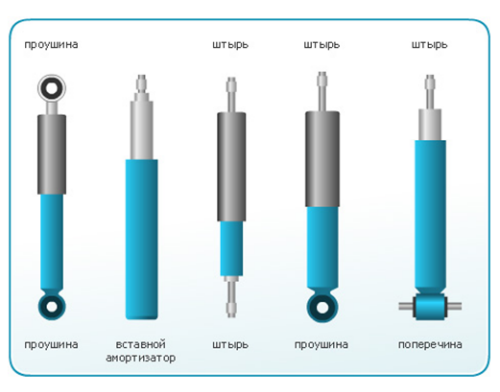
Depending on the car model, shock absorbers as part of the suspension can be attached to different options... The most common mounting options are lug-lug, lug-pin, pin-pin. In addition to these fastening variations, there are also such fastening schemes: a pin-crossbar, a plug-in shock absorber.
The role of the shock absorber device in the car suspension
The shock absorber is intended primarily for damping vertical vibrations of the car body when driving on uneven road surfaces. But this wording for an ordinary motorist means absolutely nothing. After all, the fact that the shock absorber dampens vibrations well, but why did they then have so many types and designs if the goal is one. For this, it should be clearly understood in which cases vertical body vibrations may occur. After all, this is not only movement over pits and bumps, but also maneuvering, especially at high speed. For example, during dynamic acceleration, a large load and the mass of the body is shifted to the rear axle, thereby unloading the front wheels, this significantly reduces them. In case of emergency braking the situation is completely opposite. When cornering at high speeds, the weight of the car also shifts to the outside of the turn, this also causes unstable grip of the car's wheels on the road. And in order to minimize this kind of load as much as possible different wheels and use shock absorbers of the most different types and designs.
Video - car shock absorbers
Conclusion!
Therefore, when choosing shock absorbers for your car, first of all, you should not be guided by advertising or the manufacturer's brand. First of all, you need to decide what characteristics your car should have. Be hard and sharp for a sporty and dynamic driving experience, or vice versa soft and roll for a calm and smooth driving experience. Therefore, choosing a shock absorber is about finding a balance between comfort and precision in driving.
This was told by the author of the project, a member of the Moscow City Duma Advisory Board, Vladimir Chibirev. According to him, it is proposed to extend the experience of the HLW to the entire capital, where almost all free public toilets have such parking, according to m24.ru. It is assumed that parking places will appear not only next to city toilets, but also next to modules of commercial ...
The State Duma approved a bill on deprivation of rights for three traffic violations
For the adoption of the bill submitted to the State Duma by the government, 403 deputies voted, 40 were against, two more abstained, Interfax reports. The document presupposes inclusion in Administrative Code of the article 12.38, according to which drivers who violated traffic rules and were punished three or more times for this will be deprived of their rights for a period of 1 to 1.5 ...
The Germans made a luxurious office on wheels
Appearance the car has not changed very much: 18-inch wheel disks, bi-xenon headlights and new bumper with LED "mustache" daylight... Nothing is said about pumping the engine, which, apparently, simply did not exist. But the Germans reported that for a smooth ride they provided the car with air suspension. But as far as the salon is concerned, then cardinal ...
TsODD: Moscow will rise after the holiday season
According to the deputy head of the Moscow data center, Alexander Polyakov, travel time in Moscow will increase by 36% on average due to the end of the vacation period in early September, Interfax reports. Polyakov also noted that the main difficulties will be observed in the period from 7:00 to 9:00 and from 16:00 to 20:00. During the evening rush hour, the greatest traffic difficulties will be ...
Popular russian SUV celebrating birthdayRecall that Chevrolet niva- this is VAZ "Niva" of the second generation. At the beginning of the 2000s, AvtoVAZ was able to master small-scale production of a new generation of an SUV, but due to insufficient funding, it was not possible to launch a full-scale production of the VAZ-2123. In 2002, the compromise was the creation of joint venture GM-AvtoVAZ, to which the license for the model was transferred, ...
Pokemon Go first became the cause of the accident
According to Carscoops, the 28-year-old gamer from Auburn, NY has been hunting rare Pokémon on his smartphone. He used his brother's car as a vehicle. Distracted by a game event, an inattentive player drove to the side of the road and crashed into a tree at high speed. Fortunately, the man was not seriously injured, escaping with only minor bruises. ...
Today we will be looking at six crossovers: Toyota RAV4, Honda cr-v, Mazda CX-5, Mitsubishi outlander, Suzuki grand Vitara and Ford Kuga... To two very fresh new products, we decided to add the debuts of 2015, so that the test drive of 2017 crossovers was more ...
HOW to order a car from Japan, a car from Japan in Samara.
How to order a car from Japan Japanese cars- sales leaders all over the world. These machines are valued for their reliability, quality, maneuverability and trouble-free repair. Today car owners want to be sure that the car came directly from Japan, and ...
Which cars are the safest
When deciding to purchase a car, first of all, many buyers pay attention to the operational and technical properties cars, its design and other paraphernalia. However, not all of them think about the safety of the future car. Of course, this is sad, because often ...
HOW to order a car from Germany, how to order a car from Germany.
How to order a car from Germany There are two options for buying a used one german car... The first option involves an independent trip to Germany, selection, purchase and driving. But this method is not suitable for everyone due to lack of experience, knowledge, time or desire. The way out is to order a car ...
Crises and the financial situation are not very conducive to buying a new car, especially in 2017. Only everyone has to drive, and buy a car for secondary market not everyone is ready. There are individual reasons for this - who is not allowed to travel by origin ...
Which cars are most often bought in Russia in 2017-2018?
The number of cars on the roads of the Russian Federation is constantly growing - a fact that is confirmed by the annual research of sales of new and supported models. So, based on the results of the study, which can answer the question of what cars are bought in Russia, in the first two months of 2017 ...
Reliability of machines by ratingWhat are reliability ratings used for? Let's be honest with each other, almost every motorist often thinks: the most reliable car- mine, and it does not give me a lot of trouble with various breakdowns. However, this is just the subjective opinion of each car owner. By purchasing a car, we are in ...
Rating of the best selling cars 2017-2018 model yearSince the time of Cagnoton's first steam propulsion device, invented in 1769, the automobile industry has made great strides. The variety of brands and models currently boggles the imagination. Technical equipment and the design will satisfy the needs of any of the buyers. Buyability of a particular brand, the most accurate ...
- Discussion
- In contact with
A very sensible article, everything is intelligibly and competently explained, Thank you.
Hello dear motorists! We are so accustomed to comfortable movement in the car, without shaking, without sharp rolls, that we don’t even think about how this comfort is achieved. The answer lies on the surface. In the suspension of a car, one of the leading roles is played. Only four small mechanisms, but how important they are for a modern dynamic car.
A shock absorber is a device on whose "fragile shoulders" a number of critical tasks: mitigation of shocks when driving a car, damping (suppression of mechanical vibrations), influence on the braking and acceleration dynamics of a car, and so on.
Have you ever thought about how and why the shock absorber device, seemingly a simple pipe, allows it to perform the task of constant contact of the car wheels with the road? Not? Let's take a look at how the shock absorber works for information. Maybe this knowledge will help you with.
Features when choosing shock absorbers
When choosing shock absorbers, your job is to pay less attention to the brand. The operation of a shock absorber involves many nuances that must be considered when buying and installing a shock absorber.
- The choice of the type of shock absorber, which provides the optimal balance between comfortable overcoming road irregularities, and vehicle handling.
- Heat generation (heat removal). The stiffness of the shock absorber is affected by high viscosity working fluid and a decrease in the bypass holes of the piston, which accordingly increases the temperature during the operation of the shock absorber.
- Aeration when mixing the working fluid and gas in shock absorbers with gas pressure. The disadvantage is that when mixing, foam is formed, which, unlike oil, is compressed, thereby reducing the effectiveness of the damping of the shock absorber.
- The location of the shock absorber directly affects the damping efficiency. Most the best option shock absorber location - vertical minimum angular deviation.
General classification of shock absorbers for the consumer market:
- By design: one-tube and two-tube shock absorbers.
- By filling with a working substance: hydraulic (oil), gas (with hydraulic gas pressure). Also, there are only gas shock absorbers(gas pressure 4-10 atmospheres), but they use little demand from the consumer.
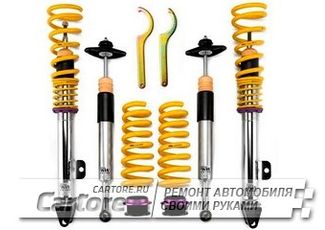
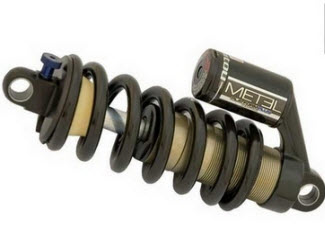
The main parts of all types of shock absorbers, taking into account design features are:
- case with an eyelet.
- shock absorber cylinder,
- shock absorber rod complete with a casing and an attachment eye,
- piston and compression and recoil valves and rings
- shock absorber spring,
- sealing elements
The most effective shock absorber is a double-acting hydraulic shock absorber.
The shock absorber is based on an internal slave cylinder containing shock absorber oil (hydraulic fluid).
When compressed, when the shock absorber rod enters, hydraulic fluid is pumped through a valve on the shock absorber piston. The working cylinder contains a piston rod with a valve system. A compression valve is located at the bottom of the working cylinder, which connects the intracylinder cavity with the cavity located between the shock absorber housing and the working cylinder.
- Shock absorber rod - the most important detail shock absorber. Its outer surface is made of a polished chrome finish. To protect the rod, a shock absorber boot is installed, which prevents foreign particles from entering the rod mirror. If the mirror of the rod is broken (chrome plating, chipping) occurs rapid wear cuffs. And, as a result, the loss of tightness of the shock absorber.
- To center the rod relative to the body, a shock absorber guide bush is used. Structurally, the bushing is pressed into the shock absorber housing.
The shock absorber strut support is used to attach the shock absorber to the car body. In addition, the shock absorber support is designed to improve the connection between the shock absorber and the vehicle chassis.
The shock absorber support bearing and the shock absorber bumper (rubber gasket) are the main parts of the support. You can determine the failure of the shock absorber support yourself: visual inspection, or when the car is moving on uneven roads, dull blows are heard in the body.
A feature of the shock absorber device for passenger cars is that the rear shock is more powerful than the front shock. This is due to the calculation full load trunk (back) of the car. If one shock absorber fails, as a rule, both shock absorbers on the same axle are replaced. Shock absorbers are repaired, but modern shock absorbers are basically non-separable. Therefore, you only need knowledge of the shock absorber device for information.
The shock absorber device is fully consistent with the functionality of the suspension, providing comfortable travel on roads with different surfaces and conditions. The main unit is a cylinder with a piston, bypass valves... Reliability of contact of the wheels with the road depends on the composition of the mixture filling the cylinder. There are hydraulic, hydropneumatic modifications that duplicate the mechanical spring, which is present in some models. "Soft" suspension is necessary for rough roads, "hard" is better for keeping the car on the road in the urban cycle.
Double tube shock absorber
The two-pipe type stand design dominates the market. During compression, the hydraulic mixture flows from a cylinder of a smaller diameter to a larger one, compresses the air located there. On rebound, the valve opens, the liquid returns to the inner flask. The main characteristics of the oil / gas used to fill the flask are incompressibility, viscosity.
The disadvantage of the scheme is the excessive saturation of the mixture with air, since it flows from cylinder to cylinder through different valves(aeration phenomenon). When the machine is moving, mechanical energy (body vibrations on uneven roads) is converted into thermal energy (expansion / contraction of the hydraulic mixture). The double hull is less cooled, therefore, this device the shock absorber is not effective enough. Two-pipe models cannot be installed with the down stem position as this will ensure incorrect operation.
Single pipe rack
The single-tube shock absorber device differs from the previous version by the valves built into the piston (De Carbon system). When using a hydropneumatic mixture, the gas is separated from the liquid by a floating piston. Cooling of this design is more efficient, however, the design of the valves becomes more complicated. In certain modifications, holes and grooves are used. A car using this shock absorber device more confidently "holds the road." With the same dimensions, the one-pipe model has a larger volume of the working chamber. Piston gas separation allows any mounting option (stem up / stem down). Wherein unsprung weight the car is dropping.
The disadvantages of this rack are:
- vulnerability - the unit is sensitive to mechanical damage, any dent in the case guarantees the need for replacement
- intensive heat exchange - single-tube struts are dependent on the ambient temperature, characteristics change in different weather conditions, the suspension becomes softer in cold weather, harder in heat
To improve the characteristics of the shock absorber, manufacturers use the removal of the hydraulic, gas chambers outside the cylinder. Thus, without changing the dimensions, the volume of the working mixture increases, the dependence on the weather disappears, and the stroke of the rod increases. Compression valves installed in the oil flow channels allow changing / adjusting the operating modes (speed, stroke length, stiffness).
Hydraulic shock absorber
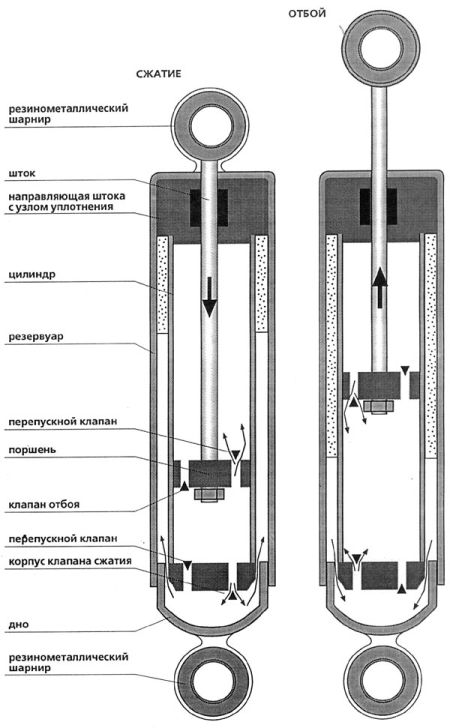
In spite of simple scheme shock absorber, it can change the characteristics due to additional built-in units. Each brand of car has its own individual characteristics, therefore, the struts should take into account vibration amplitudes, driving modes, driving style. At closed valves, when the fluid moves along the bypass channel, an absolutely rigid system is obtained. An open balancing chamber valve adds flexibility to the system. Different inlet cross-sections, exhaust valves create an asymmetrical system. Center valves on the piston create a non-linear "soft" strut system.
Gas-hydraulic shock absorber
The scheme of this car shock absorber has slight differences from the previous version. High pressure gas is held inside by cuffs, gaskets. Manufacturers use nitrogen or other inert gases instead of air. Smaller racks are filled with gas high pressure, and vice versa. In addition, the gas pressure of the shock absorber of the car in the front, rear nodes is also different. On the classic VAZ, the springs are installed separately, on other models the racks are assembled into one unit with an external arrangement of the spring, a special mount. In this case, the spring is not always the main element of the unit, but, only, duplicates the hydraulics.
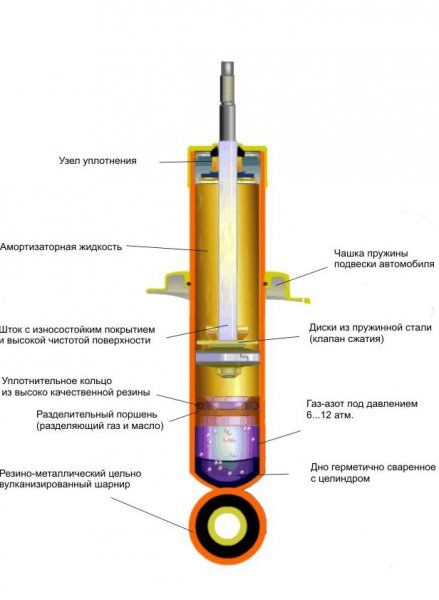
The height of the rack is adjusted with a nut, allowing you to change the vehicle's ground clearance. The following fastening of the car shock absorber to the body, suspension is possible:
- eyelet / eyelet
- pin / pin
- bottom lug / pin
- lower cross member / upper pin
- plug-in shock absorber
The first three options are most often used, as the most convenient to install.
The role of the shock absorber in the suspension of a car
The unit is designed to damp vibrations of the car body (vertical). They occur when driving on uneven roads, dynamic acceleration, and hard braking. Cornering at speed reduces traction. A variety of designs, mixtures are due to different operating conditions of the vehicle. An increase in the viscosity of the fluid used leads to an increase in "hardness", increased heat generation.
Car shock absorber or the so-called "amort" - special device in the suspension of a car, the purpose of which is, the reduction of mechanical vibrations (damping) during movement or their complete absorption.
Photo gallery:
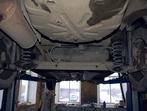

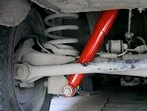
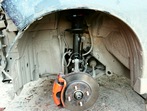
The role and purpose of shock absorbers in a car suspension
Shock absorbers give a soft and smooth ride to the car, and also protect the elements of the chassis from loads resulting from movement on an uneven road surface. Automotive shock absorbers are used as part of the elastic elements in the vehicle suspension together with springs, torsion bars and springs.
Shock absorber device
Car shock absorber consists of: a seal assembly, a car suspension spring cup, a rod with wear-resistant coating and a high surface finish, a compression valve, o-ring made of high quality rubber, separating piston, rubber-metal one-piece vulcanized joint, hermetically welded bottom, shock-absorbing liquids and gases, bulb and piston.
Varieties of shock absorbers
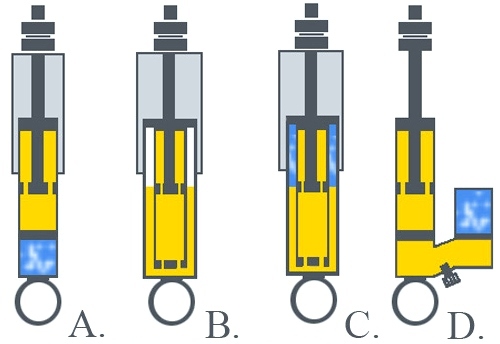
Types of shock absorbers: A. - one-pipe gas, B. - two-pipe oil, C. - two-pipe gas, D, - gas with a remote chamber
Types and structure of shock absorbers
By constructive decision there are shock absorbers:
- With two-pipe working chamber... The principle of operation of this type of shock absorber is that the piston located in the inside of the flask moves during oscillation, passing the shock-absorbing liquid through special channels and squeezes out some of the liquid (oil) through the compression valve;
- Single-tube shock absorbers... This type of construction consists of a working cylinder and a housing at the same time. In such a shock absorber, liquid and gas are in the same cylinder with the piston. V this type There is no compression valve, as in a two-pipe one, so the piston performs the entire robot to control the compression resistance. Single-tube shock absorbers more accurately hold the car on road surface... Shock absorbers with a separately placed compensation gas chamber outside the shock absorber into a separate reservoir are also disguised as a one-tube one.
Shock absorber problems
Car shock absorber struts have several main reasons for failure - these are incorrect installation and violation of operating rules. Mostly inexperienced car owners may forget to tighten the nut, put removable cups upside down, forget to install anthers, damage the shock absorber rod with pliers, etc.
Problems that you most often have to face:
Ways to identify problems with shock absorbers and their solutions
There are a lot of reasons why the shock absorber is damaged. So, for example, a rupture of the stuffing box can be caused by damage to the chrome plating of the stem or by corrosion. In the practice of car repair, there are several ways how it happens diagnostics of shock absorbers:
Failed shock absorbers can cause rapid wear of the mechanical components of the car: suspension springs, steering gear, differential, rapid tire wear, quick failure rubber bushings pendants, wheel bearings, suspension and CV joints.
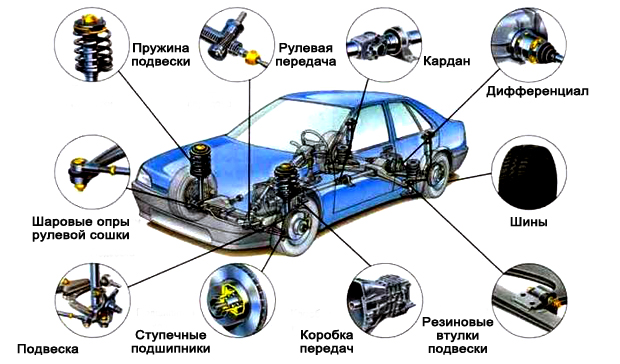
Units that are adversely affected by faulty shock absorbers
The importance of a shock absorber in a car's suspension
Basically, drivers pay little attention to shock absorbers and consider them workable until, overcoming irregularities, a metallic shock is heard, and the vibrations of the car quickly calm down. Checking the condition is mainly carried out only by a rough method by swinging the machine with your hands. It is possible to determine exactly the characteristics of a car's shock absorber only at special stands, in a service station.



